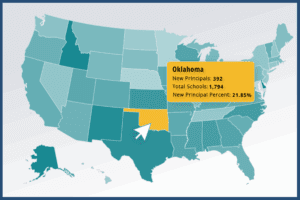
How Many Education Workers Are in the U.S.? Roles, Trends + Market Impact
Discover how many education workers are in the U.S., including key roles and trends—and learn how vendors can engage decision-makers effectively.
Under the Every Student Succeeds Act (ESSA), states are required to identify schools in need of targeted support—and those schools can’t improve alone. They need the right resources, partners, and tools to move the needle on student performance. Certain designations spotlight schools that need intervention. But knowing which schools are targeted—and why—requires accurate, up-to-date data.
We’re breaking down how states identify underperformance and share how vendors can use school and student performance data to connect with and support the schools that need it most.
ESSA, or the Every Student Succeeds Act, is a federal education law passed in 2015 that replaced No Child Left Behind. It gives states more flexibility to set their own goals for student achievement while still holding schools accountable for performance. A key part of ESSA is identifying schools that need extra support—especially those with low test scores or persistent achievement gaps—so states can step in with targeted interventions and resources.
A targeted school list under ESSA highlights the schools that need extra support to boost student outcomes, whether it’s due to low overall performance or gaps among specific student groups. These lists help states focus their efforts and give education partners a clear signal: this is where your tools and support can make the biggest difference.
School and Student Performance Data requires action in the following types of schools:
States use several key indicators to hold schools accountable and measure how well they’re serving students. Here are the most common metrics that shape school evaluations:
States keep a close eye on student groups that often face extra challenges, including:
ESSA puts equity front and center by requiring states to disaggregate data and evaluate these subgroups separately to ensure no student is overlooked.
To flag underperformance, states look at a mix of data, from test scores and growth over time to graduation rates and more. If a subgroup falls consistently below state-set benchmarks or trails behind peers, it’s marked for targeted support. This triggers action plans designed to tackle the specific barriers those students face.
CSI schools work with districts and communities to create and carry out evidence-based improvement plans. Districts provide funding, spot resource gaps, and support schools throughout the process. States, on the other hand, identify which schools and districts need help, approve plans, set clear goals, offer technical support, and step in if progress stalls. This collaboration ensures targeted schools get focused support.
For TSI and ATSI schools, districts allocate funding, approve plans, set clear goals, and monitor progress—stepping up if schools don’t meet improvement targets. States provide funding and technical support, guide local decision-making, and may intervene if districts have many struggling schools. If ATSI schools don’t improve, states can reclassify them as CSI, triggering even more intensive support.
Schools and districts have a vital role in keeping families and communities in the loop about TSI and ATSI statuses. Being open and transparent builds trust and helps everyone understand the challenges and the action plans underway. Quick, clear communication—whether through meetings, newsletters, or digital updates—keeps families connected and involved in turning the status around.
A few key challenges create barriers for education departments trying to support targeted schools, including:
To tackle these challenges, schools and districts are adopting smarter data systems and clearer communication strategies. By standardizing reports and tracking subgroup progress more closely, they’re improving accuracy and keeping families more connected and informed.
For education technology and service vendors, targeted schools are more than just potential clients—they’re high-priority partners ready to invest in meaningful change. These schools often receive dedicated improvement funding, creating a budget specifically for resources that can help boost student outcomes. Under state scrutiny and clear mandates, they’re actively searching for effective edtech, curriculum enhancements, and instructional services that can help them meet their goals.
By aligning products with schools’ specific needs and improvement plans, vendors become trusted allies in driving real progress and success.
Let’s explore five effective ways solution providers can boost engagement with targeted schools in need of support:
Leverage detailed data to segment schools by their TSI, ATSI, or CSI status. By tailoring your outreach to address each school’s specific challenges, you demonstrate a clear understanding of their needs and make your message more relevant.
Focus your messaging on the schools’ key priorities (e.g., improving proficiency, increasing graduation rates, or supporting particular student groups). When you speak directly to their goals, schools are more likely to see your solutions as valuable partners in their improvement efforts.
Plan your outreach around important moments like budget planning or improvement plan development. Reaching out during decision-making windows increases the chances that schools will consider your offerings.
Combine email campaigns, targeted digital ads, and educator contact lists to create multiple touchpoints. This varied approach helps ensure your message reaches the right people through channels they engage with most.
Work closely with district leaders to align your solutions with district improvement plans and funding timelines. Building these partnerships makes it easier for schools to adopt your products and shows your commitment to their long-term success.
Yes. Schools that meet their improvement goals over a designated period—typically two to three years—can be removed from the targeted list. However, each state sets its own exit criteria based on benchmarks in its ESSA plan.
No. While ESSA establishes broad federal requirements, each state customizes its accountability system through its own ESSA plan. This means the criteria for underperformance and designation can differ across states.
Yes. Charter schools are subject to the same ESSA accountability standards as traditional public schools. If they serve public students and receive federal funds, they must report performance data and are evaluated based on the same criteria.
The best initial contacts are often Title I Coordinators, School Improvement Officers, Curriculum Directors, or District Accountability Leads. These individuals are closely involved in the process and may have more sway in selecting interventions or instructional tools.
Targeted schools often seek solutions that directly support measurable student growth and close equity gaps. High-priority needs include:
School and Student Performance Data accountability has reshaped how states identify and support underperforming schools—creating clear opportunities for education vendors to make a real impact. But connecting with targeted schools and understanding their specific needs often requires precise, data-driven insights.
Agile Education Marketing helps solution providers build accurate, high-performing school lists, so you can stop wasting time and resources on the wrong audiences. Partner with Agile to target the right schools and drive meaningful engagement that supports student success.
Looking to improve your school marketing? Reach out to connect.

Discover how many education workers are in the U.S., including key roles and trends—and learn how vendors can engage decision-makers effectively.

Every new school year brings fresh priorities – and workforce data offers a unique window into how education is changing. Agile’s latest analysis shows a clear shift in how districts and schools are preparing for the future.

Discover effective email marketing strategies for vendors targeting K–12 schools. Learn segmentation, personalization, timing, and best practice tips.
We use cookies to ensure you get the best experience on our website. Learn more.
We’re here ready to answer your questions! Share a little information with us below and one of our Agile experts will be in touch shortly.